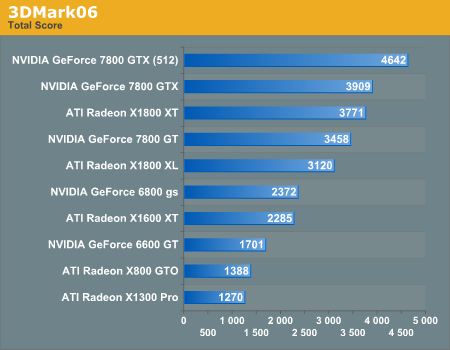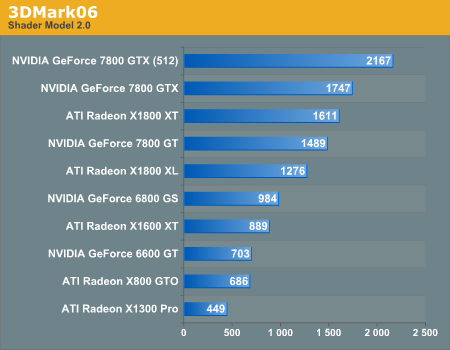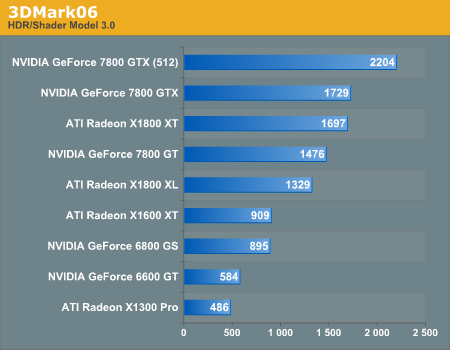Futuremark's Latest Attempt: 3DMark06 Tested
by Josh Venning on January 18, 2006 11:00 AM EST- Posted in
- GPUs
Performance Tests
We ran several tests with the latest version of 3DMark to see what kind of results we would get across a range of NVIDIA and ATI cards. There are a number of different tests that 3DMark can perform to stress different aspects of the system, but the three tests that we will be focusing on here are Shader Model 2.0 graphics, HDR/Shader Model 3.0 graphics, and the overall score. Here is what we tested:
NVIDIA 6600 GT
NVIDIA 6800 GS
NVIDIA 7800 GT
NVIDIA 7800 GTX
NVIDIA 7800 GTX 512
ATI X800 GTO
ATI X1300 Pro
ATI X1600 XT
ATI X1800 XL
ATI X1800 XT
MSI K8N Neo4 Platinum/SLI motherboard
AMD Athlon 64 FX-55 Processor
2x512MB OCZ 2-2-2-6 1T DDR400 RAM
Seagate 7200.7 120 GB Hard Drive
OCZ 600 W PowerStream Power Supply
The 3DMark06 benchmark is very straightforward. There are different settings that can be changed such as resolution and Anti-Aliasing, and clicking "Run 3DMark" will run the demos back-to-back and display the results when finished. For these tests, we chose the default resolution of 1280X1024 (no AA or AF).



(Note that in the HDR/SM3.0 graph, the X800 GTO is not included as it is incapable of rendering these effects.)
We can see by the graphs that 3DMark's graphics tests favor NVIDIA hardware over ATI, which is a further illustration of why 3DMark isn't really the best program for performance testing between cards. We know that different games tend to do better or worse on different hardware depending on the way the game was made, so a tool like 3DMark won't necessarily determine which card would be best suited for a specific game. This is an important fact for users in the market for a new card to realize before they spend their hard-earned money.
3DMark06 is a very stressful benchmark and as could be expected, some of the less powerful cards ran the demos very slowly. Because the graphics are so intensive, the effects were quite stunning, especially on the high end cards like the 7800 GTX (512) and the X1800 XT. During the firefly scenes, the warm glow of the fireflies in the night created intricate, hypnotic reflections of the foliage, and the brilliant white of the snow and sun in the arctic outpost demo at the end were striking. But at the end of our testing, we are mostly left with shallow beauty rather than a deep, meaningful connection. The overall 3DMark scores don't really give us much more information than we already have; other than simply letting us know what hardware runs 3DMark better.
We ran several tests with the latest version of 3DMark to see what kind of results we would get across a range of NVIDIA and ATI cards. There are a number of different tests that 3DMark can perform to stress different aspects of the system, but the three tests that we will be focusing on here are Shader Model 2.0 graphics, HDR/Shader Model 3.0 graphics, and the overall score. Here is what we tested:
NVIDIA 6600 GT
NVIDIA 6800 GS
NVIDIA 7800 GT
NVIDIA 7800 GTX
NVIDIA 7800 GTX 512
ATI X800 GTO
ATI X1300 Pro
ATI X1600 XT
ATI X1800 XL
ATI X1800 XT
MSI K8N Neo4 Platinum/SLI motherboard
AMD Athlon 64 FX-55 Processor
2x512MB OCZ 2-2-2-6 1T DDR400 RAM
Seagate 7200.7 120 GB Hard Drive
OCZ 600 W PowerStream Power Supply
The 3DMark06 benchmark is very straightforward. There are different settings that can be changed such as resolution and Anti-Aliasing, and clicking "Run 3DMark" will run the demos back-to-back and display the results when finished. For these tests, we chose the default resolution of 1280X1024 (no AA or AF).



(Note that in the HDR/SM3.0 graph, the X800 GTO is not included as it is incapable of rendering these effects.)
We can see by the graphs that 3DMark's graphics tests favor NVIDIA hardware over ATI, which is a further illustration of why 3DMark isn't really the best program for performance testing between cards. We know that different games tend to do better or worse on different hardware depending on the way the game was made, so a tool like 3DMark won't necessarily determine which card would be best suited for a specific game. This is an important fact for users in the market for a new card to realize before they spend their hard-earned money.
3DMark06 is a very stressful benchmark and as could be expected, some of the less powerful cards ran the demos very slowly. Because the graphics are so intensive, the effects were quite stunning, especially on the high end cards like the 7800 GTX (512) and the X1800 XT. During the firefly scenes, the warm glow of the fireflies in the night created intricate, hypnotic reflections of the foliage, and the brilliant white of the snow and sun in the arctic outpost demo at the end were striking. But at the end of our testing, we are mostly left with shallow beauty rather than a deep, meaningful connection. The overall 3DMark scores don't really give us much more information than we already have; other than simply letting us know what hardware runs 3DMark better.










45 Comments
View All Comments
Mant - Wednesday, January 18, 2006 - link
Quote: "But at the end of our testing, we are mostly left with shallow beauty rather than a deep, meaningful connection."wtf?
stephenbrooks - Thursday, January 19, 2006 - link
Quote: "But at the end of our testing, we are mostly left with shallow beauty rather than a deep, meaningful connection."Ah, but on the other hand, "There are likely many other uses for this program which we can't mention here".
In any case, this is way more interesting than your average graphics benchmark review.
Mant - Wednesday, January 18, 2006 - link
In case you think I'm making that up, its at the end of Page 3. Methinks Josh needs Elimidate more than 3DMark06Orbs - Thursday, January 19, 2006 - link
LOL! I love Elimidate, although Elimidate would not provide a deep, meaningful connection, but more shallow beauty (admitedly, whoring themselves in public and bitching at each other at an ever increasing volume). Good times.peldor - Wednesday, January 18, 2006 - link
"Right now, the hardware that is available is prompting advancements in game development, and we can't easily predict what types of games we might see in the near or semi-near future."You mean we won't have more WW2 shooters, with the occassional relief Zombie Mutant Alien? But now everything will have Bright Lights and Dark Shadows! Because that seems extremely likely to me. Game developers rarely chase new game types, and it's not really the hardware that motivates them AFAICT.
KingofL337 - Wednesday, January 18, 2006 - link
Whats the relation ship of these cards. Which is ahigher performance part?
JarredWalton - Wednesday, January 18, 2006 - link
X800 Pro = 12 pipelines at 475 MHz and 980 MHz GDDR3 RAM.X800 GTO = 12 pipelines at 400 MHz and 980 MHz GDDR3 RAM.
However, many people have had success in unlocking and/or overclocking GTO cards. If you can get 16 pipelines at 475 MHz, for example, it would be 33% faster on the core than the Pro. If you just overclock to 475 MHz and don't unlock the pipelines, you've got an X850 Pro. (R480 core vs. R420 core, I think? It doesn't make much difference, though.)
DigitalFreak - Wednesday, January 18, 2006 - link
Let the driver "optimizations" begin!PeteRoy - Wednesday, January 18, 2006 - link
No Intel vs AMD?ViRGE - Wednesday, January 18, 2006 - link
3dMark is and always has been primarily a GPU-oriented benchmark, Intel vs. AMD wouldn't tell us much if the GPU is the bottleneck(and if it isn't, all it would tell us is that AMD outperformed Intel like they tend to do in these kinds of tests).